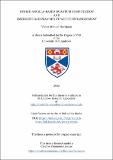Files in this item
Hybrid ancilla-based quantum computation and emergent Gaussian multipartite entanglement
Item metadata
| dc.contributor.advisor | Korolkova, Natalia | |
| dc.contributor.author | Nordgren, Viktor Manuel | |
| dc.coverage.spatial | 171 | en_US |
| dc.date.accessioned | 2023-03-02T09:30:45Z | |
| dc.date.available | 2023-03-02T09:30:45Z | |
| dc.date.issued | 2023-06-12 | |
| dc.identifier.uri | https://hdl.handle.net/10023/27084 | |
| dc.description.abstract | In the first half of this thesis, we present two models of ancilla-based quantum computation (ABQC). Computation in the ABQC models is based on effecting changes on a register through the interaction with and manipulation of an ancillary system. The two models presented enable quantum computation through only unitary control of the ancilla – the ancilla-controlled model (ACQC) – or supplemented by measurements on the ancilla which drive the register transfor- mations – the ancilla-driven model (ADQC). For each of the models, we work on systems which couple two continuous variables (CV) or which are hybrid: the register is formed by two-level systems while the ancilla is a CV degree of freedom. The initial models are presented using eigenstates of momentum as the ancillas. We move to a more realistic scenario by modelling the ancillas as finitely squeezed states. We find that the completely unitary ACQC contains persistent entanglement between register and ancilla in the finite-squeezing scenario. In the ancilla-driven model, the effect of finite squeezing is to scale the register state by a real exponential which is inversely proportional to the squeezing in the ancilla. In the second part, we cover work on Genuine Gaussian Multipartite Entanglement (Gaussian GME). We present an algorithm for finding Gaussian states that have GME despite having all two-state reductions separable. This touches on the idea of entanglement as an emergent phenomenon. We determine GME via witnesses which probe only a subset of the state. We therefore referred to them as partially blind witnesses. The algorithm is based on semi-definite programs (SDPs). Such optimisation schemes can be used to efficiently find an optimal, partially blind, GME witness for a given CM and vice versa. We then present results of multipartite states of up to six parties. For the tripartite example, we present two experimental schemes to produce the state using a circuit of beam-splitters and squeezers. | en_US |
| dc.language.iso | en | en_US |
| dc.rights | Creative Commons Attribution-ShareAlike 4.0 International | * |
| dc.rights.uri | http://creativecommons.org/licenses/by-sa/4.0/ | * |
| dc.subject | Quantum information | en_US |
| dc.subject | Quantum computation | en_US |
| dc.subject | Models of computation | en_US |
| dc.subject | Quantum correlations | en_US |
| dc.subject | Entanglement | en_US |
| dc.subject | Entanglement witness | en_US |
| dc.subject | Multipartite entanglement | en_US |
| dc.subject | Genuine multipartite entanglement | en_US |
| dc.subject | Semidefinite program | en_US |
| dc.subject | Emergent properties | en_US |
| dc.subject | Marginal problem | en_US |
| dc.title | Hybrid ancilla-based quantum computation and emergent Gaussian multipartite entanglement | en_US |
| dc.type | Thesis | en_US |
| dc.contributor.sponsor | Engineering and Physical Sciences Research Council (EPSRC) | en_US |
| dc.type.qualificationlevel | Doctoral | en_US |
| dc.type.qualificationname | PhD Doctor of Philosophy | en_US |
| dc.publisher.institution | The University of St Andrews | en_US |
| dc.identifier.doi | https://doi.org/10.17630/sta/316 | |
| dc.identifier.grantnumber | 1947916 | en_US |
The following licence files are associated with this item:
This item appears in the following Collection(s)
Except where otherwise noted within the work, this item's licence for re-use is described as Creative Commons Attribution-ShareAlike 4.0 International
Items in the St Andrews Research Repository are protected by copyright, with all rights reserved, unless otherwise indicated.


